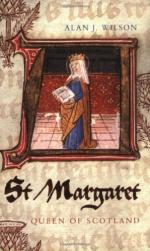|
This section contains 401 words (approx. 2 pages at 300 words per page) |
Encyclopedia of World Biography on Margaret of Scotland, St.
St. Margaret of Scotland (1045-1093), wife of the Scottish king Malcolm III, introduced important religious reforms into Scotland and was a civilizing agent in the social life of that country.
Information about the early life of Margaret is based on tradition; for her later years there is a dependable Life of St. Margaret, written by her confessor, Turgot. After some years spent in exile in Hungary, Margaret and her family returned to their homeland, England, in 1057. With the seizure of the English crown by William the Conqueror in 1066, Margaret's brother, Edgar Atheling, was clearly unable to realize his own claim to kingship, and soon the family was forced to flee the land. They sailed for the Continent, but contrary winds carried them to Scotland, where Malcolm offered first hospitality and then a marriage that in time produced eight children. Of the six sons, three became kings of Scotland, and one daughter, Maud, was married to Henry I of England. That none of her sons was given a traditional Scottish name is evidence of Margaret's influence.
Margaret set about to reshape the religious life and social patterns of Scotland. In public religion Margaret concerned herself with practices rather than with doctrine or administration. Because certain Scottish religious customs differed from the usages of Rome and England, she caused a council to meet to deal with five points: the establishment of the initial date of Lent, the reception of Communion by the clergy at Easter, the mode of observance of the Sabbath, the manner of celebration of the Mass, and the legality of marriage between a man and his stepmother or the widow of his brother. Through persuasion and persistence Margaret caused the Scottish traditions to be abandoned, and the cultural isolation of Scotland was ended. In her private life Margaret won fame and affection for her piety, humility, and generosity to the poor.
Margaret reformed the manners of the Scottish court and further diversified the cultural life of the land. Under her leadership, ceremonies were made more elaborate; tapestries were hung on the walls; gold and silver dishes came into use; and court costumes were marked by the appearance of fur, velvet, and jewelry.
Only 3 days after her husband was killed in battle, Margaret died. So widely beloved was she that the people of Scotland immediately hailed her as a true saint. Her official canonization, however, did not come until 1250.
|
This section contains 401 words (approx. 2 pages at 300 words per page) |


